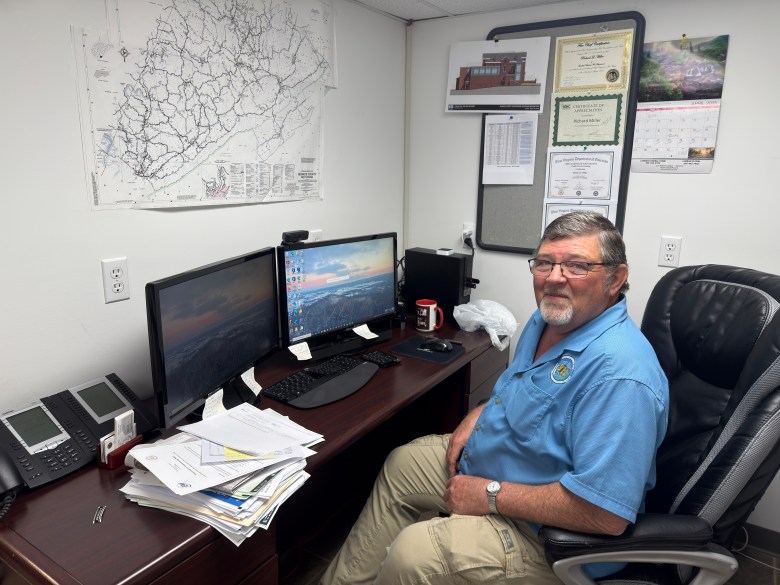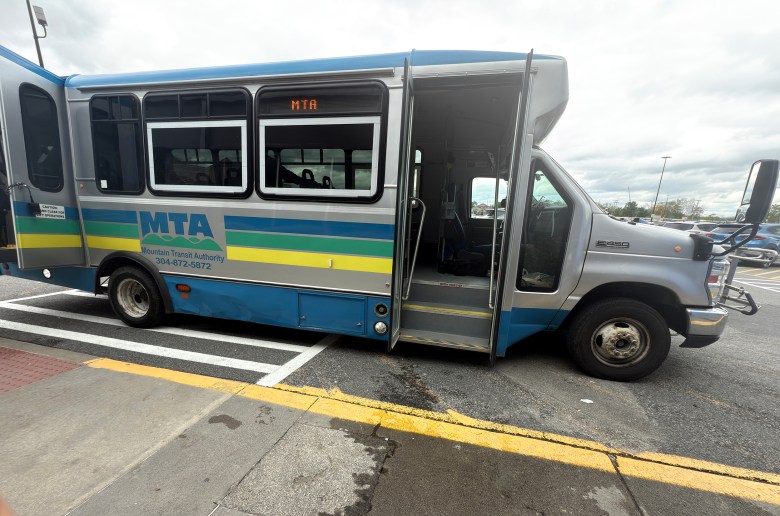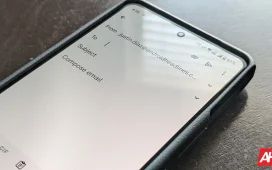GREENVILLE — Debbie Rutherford waits just outside her apartment complex in Greenville with her cloth tote bag and walker, ready for a ride she’d never imagined possible.
Four years ago, she was told by her doctor that her kidneys were failing. And she needed dialysis treatment every week, with sessions lasting three or four hours.
Treatment meant the difference between her living in pain with little energy or getting by. But the treatment was 32 miles away in Lewisburg, and Rutherford didn’t have a car.
“I was paying one lady a hundred dollars a month in gas for rides,” she said. “I missed so many trips because I didn’t have the money to go.”
But now she sits comfortably at the front of a small gray and blue bus, greets the driver by name, and rides the winding roads to her treatments.
Monroe County, with only 12,000 residents, is one of many rural West Virginia counties where a lack of public transportation has prevented residents from accessing grocery stores, doctors’ offices and jobs.

Of the states’ 55 counties, 38 have bus service and many routes are limited, running only a few days a week.
In 2023, the West Virginia Public Transit Association asked state lawmakers for $7 million to expand public transportation to all 55 counties, but received no funding.
‘The stars finally aligned’
In Monroe County, residents were tired of waiting.
For decades before the first buses rolled in March, residents like Jeana Carr had been complaining that the county needed to address the lack of a public transportation system.
Carr is the county’s Head Start director and has worked directly with families and parents since the late 1990s. She said most families either relied on one car or didn’t have one at all.
“It was just me sitting in meeting after meeting, year after year, where transportation is always the number one need on community needs assessments,” she said.

But last summer, when she met Beth Massey, the threat preparedness coordinator at the Monroe County Health Department, everything began to fall into place.
“For me, it was just like the stars finally aligned, because Beth had the time none of us ever had in the past,” she said.
From idea to reality, community members worked together
Massey and Carr approached the county commission with their concerns, and the commission formed a transportation committee, appointing Massey to lead it.
“Nobody got paid a penny for this,” she said. “We were all doing different professional roles, but creating a transportation program was not in any of our job descriptions.”
Members of the committee knew the need was there, but before they went to the state, they knew they had to prove it.
So they got creative.
They asked county residents to start reporting their transportation needs, and they worked directly with Jewell’s IGA grocery store in Union to offer $50 gift cards to randomly selected survey respondents. They worked with the county 911 office to have residents call in their responses using a non-emergency line.
About 149 responses poured in, many from seniors and retirees like Rutherford.
Richard Miller, the county’s emergency management director, was on the committee.

“When we saw the need from that point, we went to work,” he said.
Respondents cited doctors’ appointments and pharmacy visits as their top transportation needs, followed by grocery shopping. Many said they couldn’t afford gas or didn’t have friends or family members to drive them anywhere.
With data and community support, the committee approached the state’s public transit authority, the Division of Multimodal Transportation Facilities.
“We went to them and said, ‘Okay, how can you help us?’ This is what we need and this is why we need it,” Massey said.
So state officials directed them to the Mountain Transit Authority, which already operated in nearby Pocahontas and Greenbrier Counties.
And Tim Thomas, MTA’s general manager, had been looking to expand to Monroe County for a while.
Communities have to ask for help
Last year, West Virginia’s public transit division under DMTF received $14 million in federal funding to distribute to public transportation organizations across the state.
Most of the state’s rural transit is funded by the federal government through a rural transportation grant program for communities of 50,000 residents or less. State or local governments are expected to match a portion of the cost.
But state officials say it’s up to communities to ask for help and find the money.
“It’s typically a grassroots approach,” said Bill Robinson, DMTF’s public transit director. “It comes from the bottom up, not the top down.”
Thomas told the Monroe County transportation committee that startup costs to get buses running were between $130,000 and $150,000.
With the federal grant requiring a 50% match, the county commission put up $30,000, and MTA is working to put up the remaining funding to expand to more routes and days.
By early March, buses were carrying riders across the county three days a week to places as far away as Lewisburg in Greenbrier County and Princeton in Mercer County.
Since service in the county is new, MTA is still evaluating options to add more routes, drivers and buses once ridership increases.
“My philosophy is you’ve got to be able to crawl before you can walk, and you’ve got to be able to walk before you can run,” Thomas said. “We’re just taking baby steps right now.”
So far, the routes average six to 10 riders a week, with Fridays being the busiest days.
Costs also vary between the three available routes. Most trips cost from one to five dollars one way. A route from Lewisburg to Gap Mills, a 25-mile drive, costs the most at $5.50 a ride.
“It’s a learning curve for our citizens,” Miller said. “A lot of them really don’t know yet that the thing is even available. We’re starting to do public meetings across the county to try to help with that.”
MTA is also in talks with other county officials in Braxton and Clay counties to expand service there.

“We’re an economic driver,” Thomas said. “For every dollar invested in public transportation, five dollars goes back to local economies, and it’s phenomenal.”
Public transportation is an investment in economic development and can create jobs and grow tax revenues, according to a report from the American Public Transit Association.
“When economic development folks come in, the first thing they ask is if workers have access to public transportation,” Robinson said.
Robinson asked state legislators for $2.8 million to expand service on behalf of the Public Transportation Association during this year’s legislative session.
Lawmakers budgeted less than half of that for public transit. Gov. Patrick Morrisey pared this back to $750,000 of new funding.
“This is clearly a major investment, especially given West Virginia’s fiscal constraints,” said Drew Galang, a spokesperson for the governor.
He added that increasing the state’s workforce participation rate was a “top priority” for the governor.
In Greenville, residents like Debbie Rutherford are just happy to have rides. The buses might only run three days a week, but they’re running.
She said after the service became operational, her brother bought her a three-month bus pass. So rides that used to cost her $100 now cost her nothing.
And it’s made all the difference. Her health is improving.
“We’re very thankful for this bus route,” she said. “I don’t have to ask nobody to take me anywhere, I can just jump on and go.”





